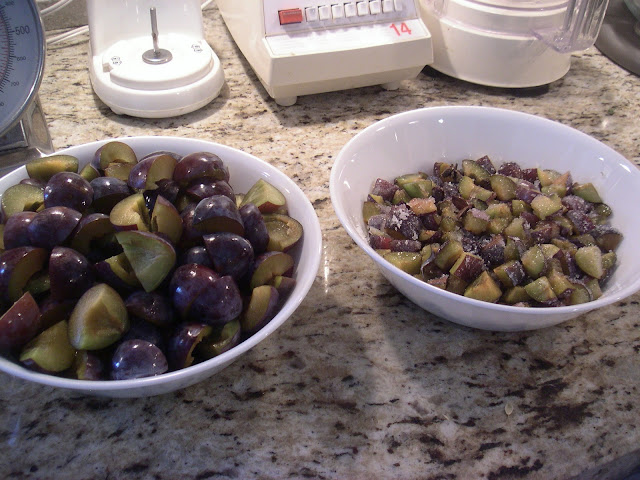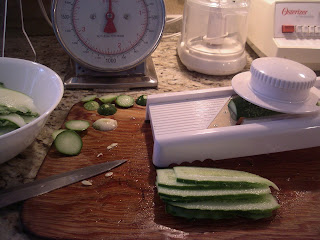It's a bit of a downer to title a post "Disappointment" but that's essentially what I'm feeling right now after having spent all morning canning. If you put up food on a regular basis, every once in a while you are bound to have a disappointing session. Today was one of those.
I always have the grandest plans when it comes to canning (as well as a lot of other areas in my life!) and so I figured it would be a snap to do the strawberries and rhubarb, followed by the peaches I bought yesterday from the farmer's market and then the collected tomatoes from my garden.
It all started encouragingly enough -- a beautiful, sunny Sunday morning, fresh Ontario strawberries and rhubarb.
The rhubarb was gifted from my friend Fred and he thoughtfully had trimmed, chopped and frozen it for me, so all I needed to do was thaw it and put it a large pot. The rhubarb released a lot of its juice during the thawing process, so there was no need to macerate it in sugar.
I didn't bother macerating the strawberries either, just trimmed, cored and halved or quartered them, adding them directly to the pot of thawed rhubarb. I reckoned I had about 6-7 cups of fruit altogether, so I guesstimated about 3 cups of sugar would do. As it turned out, I was running low on sugar and I had just over 3 cups left, so that's what I used. I didn't want to make jam, just stew the rhubarb together with the strawberries to create a sort of thick sauce to have on yogourt or oatmeal for breakfast (or over vanilla ice cream!)
Bring the whole thing to a full, rolling boil that can't be stirred down and cook until the strawberries are soft, about 10 minutes or so. Since the rhubarb had released so much juice during the thawing process, it more or less dissolved into the stew, but made for a lovely preserve nonetheless.
Ladle into hot sterilized jars and process for 20 minutes. See here for water bath canning instructions.
All in all a fine start. However, it all went downhill from here.
The peaches I bought yesterday at the farmer's market look perfect and seem completely ripe, but when I tried to blanch them to remove their skins, they wouldn't budge.
Similar to preparing tomatoes for canning whole, halved or diced, I set up a large pot of boiling water, a bowl of ice water, another bowl for the peeled peaches and a plate to catch the skins. No matter how I tried, though, the skins would not release. The peaches are obviously not as ripe as I thought they were.
So, I will leave them for a bit and hopefully they will ripen up.
After aborting the attempt to can the peaches, I turned to my meagre collection of tomatoes that I had gleaned from my garden over the past few weeks. Compared with last year, these are truly pathetic. Like the peaches, they look ripe, but when I tried blanching them, the skins were difficult to remove. I did manage to peel them all, but it took a fair bit of determination and effort. The tomatoes are small, hard and not very plump and juicy like they were last year and I put this down to the severe drought-like conditions we had here in July. Despite my regular watering, there just wasn't enough good rain. So, the garden has definitely suffered.
Having peeled and diced the few tomatoes I had, I decided at the last minute to take the collection of cherry tomatoes I had in the fridge, halve them without peeling them and add them to the diced tomatoes. A lot of the cherry tomatoes I picked recently are split, which is due to the large amount of rain we've received in a relatively short period of time over the last few weeks.
I must admit I do like the colourful mixture of the various types of tomatoes. I just wish there were more of them! So, I brought the tomatoes to a boil, then put them in hot, sterilized jars with bottled lemon juice (1 tbsp for pint jars, 2 tbsp for quarts) and processed them for 40 minutes.
All this for one 750ml (1 1/2 pint) jar and half a 1/2 pint jar. Sigh! Well, next weekend, it being the Labour Day weekend, hopefully I will have suitably ripe, fresh produce and will make up for this rather dismal canning session.





















































